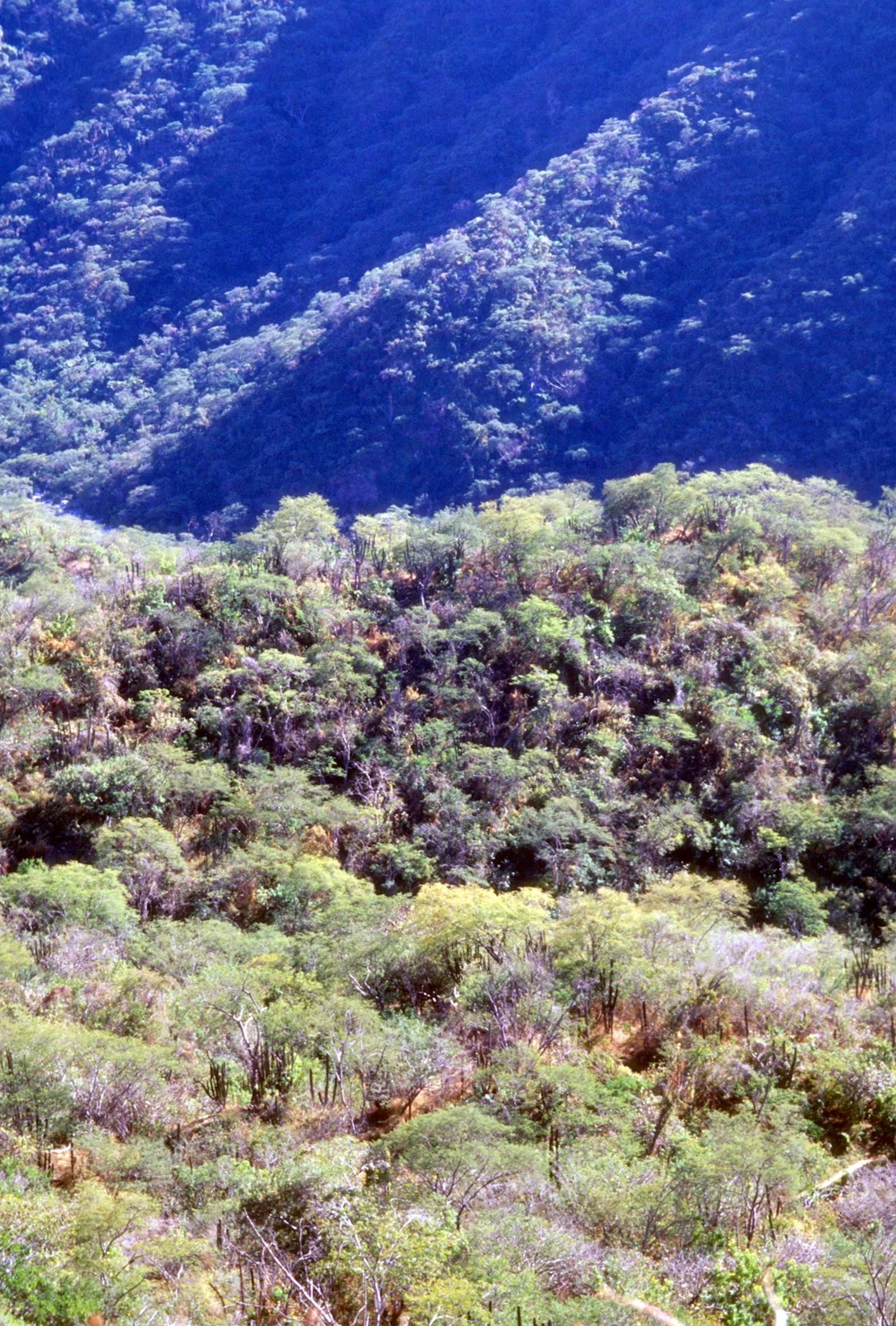Sierra de la Laguna Dry Forests
The ecoregion’s land area is provided in units of 1,000 hectares. The protection goal is the Global Safety Net (GSN1) area for the given ecoregion. The protection level indicates the percentage of the GSN goal that is currently protected on a scale of 0-10.
Bioregion: Mexican Dry & Coniferous Forests (NT28)
Realm: Central America
Subrealm: Central America
Ecoregion Size (1000 ha):
399
Ecoregion ID:
544
Conservation Target:
33%
Protection Level:
6
States: Mexico
The Peninsular myotis is a species of vesper bat endemic to the southern tip of Baja California, where the Sierra de la Laguna Dry Forests ecoregion is located. Its Latin name refers to its range, meaning "of the peninsula." These bats primarily feed on insects, using their hind legs to snatch prey out of the air. The small brown bats have relatively large ears, which they use for precise echolocation, allowing them to catch flying insects at night.
Situated at the southern end of the Baja California peninsula, this region was once an isolated island before joining the mainland. The terrain is shaped by a vast complex of granitic mountains that run southward from the Gulf of California to the Pacific. These mountains are intersected by valleys and canyons and are surrounded by expansive plateaus.
The topographical variations contribute to the diversity of climates and vegetation throughout the region. Subtropical dry forests, receiving less than 500 mm of precipitation per year, dominate the lower portions of the mountains (300–800 m). The trees must endure a long dry season, and most lose their leaves during this period.
.%20Image%20credit%20Marlin%20Harms%20via%20Flickr%2C%20CC%20by%202.0.jpg)
The Xantus's hummingbird (Basilinna xantusii) is the flagship species of the Sierra de la Laguna Dry Forests ecoregion. Image credit: Marlin Harms via Flickr, CC by 2.0
The forest serves as a transition zone between the pine-oak forests found at higher elevations and the xeric scrub at lower altitudes. The dry forest of Sierra de la Laguna is characterized by an abundance of low-growing trees and shrubs. Notable trees include mauto, palo blanco, elephant tree, and palo zorrillo, while the scrub vegetation features species such as mala mujer, buena mujer, and biznaga cacti.
The past and present isolation of the Sierra de la Laguna from the rest of the peninsula has played a major role in fostering a remarkable variety of unique species. There are 224 species of vascular plants inhabiting the Sierra de la Laguna dry forests. The ecoregion is home to half of the reptile and amphibian species found in the Sierra de la Laguna, over 29 of its 194 bird species, and 29 of its 40 mammal species. More than 10% of the plant and animal species found in Sierra de la Laguna are endemic.
This isolation has also led to a scarcity of predators and has diminished the competitive abilities of some animals. Characteristic fauna of the region include the southern pocket gopher, badger, Gilbert’s skink, Baja California striped whipsnake, Xantus's hummingbird, and northern pygmy owl.
.%20Image%20credit%20%C2%A9%20Ianmaton%20%7C%20Dreamstime.jpg)
Northern pygmy owl (Glaucidium californicum). Image credit: © Ianmaton | Dreamstime
Subtropical dry forests are often among the most threatened habitats, and Baja California Sur boasts some of the highest biodiversity within these ecosystems. While portions of the Sierra de la Laguna dry forests remain intact, accessible areas are increasingly being converted for cattle grazing.
So far, there has been no significant fragmentation of the habitat, largely due to the limited exploitation of forest resources. In June 1994, the region was designated a Protected Natural Area, with the pine-oak forests and subtropical dry forests identified as key areas for conservation.
The fragile nature of this region requires long-term legal protection to prevent disturbances caused by human overpopulation and the exploitation of forest resources for livestock. Local villagers often kill carnivores and other "problem" species they see as threats to their domestic animals.
Although human impact on Sierra de la Laguna has been kept to a minimum, any uncontrolled disruption to this delicate ecosystem could create an imbalance. This could ultimately lead to the disappearance of the extraordinary evolutionary phenomena that produce such a unique vegetation assemblage in the midst of a vast desert.
Priority conservation actions for the next decade include:
- Organizing awareness and educational workshops for locals on the values of biodiversity.
- Promoting sustainable cattle ranching methods.
- Ensuring continued and enhanced protection measures for the ecoregion.
-
-
1. Valero, A. Schipper, J. Allnut, T. 2019. Sierra de la Laguna dry forests https://www.worldwildlife.org/ecoregions/nt0227 Accessed June 25, 2019.
2. Gallina-Tessaro, P., A. González. 1988. Mastofauna. Pages 209-228 in L. Arriaga and A. Ortega (editors), La Sierra de la Laguna de Baja California Sur. Centro de Investigaciones Biológicas de Baja California Sur, México.
3. Arriaga, L. and A. Ortega (editors). 1988. Características generales. Pages 15-26 in La Sierra de la Laguna de Baja California Sur. Centro de Investigaciones Biológicas de Baja California Sur, México.
4. Arroyo-Cabrales, J. & Ospina-Garces, S. 2016. Myotis peninsularis. The IUCN Red List of Threatened Species 2016: e.T14189A22066405. http://dx.doi.org/10.2305/IUCN.UK.2016-1.RLTS.T14189A22066405.en. Downloaded on 26 June 2019. -
Cite this page: Sierra de la Laguna Dry Forests. Ecoregion Snapshots: Descriptive Abstracts of the Terrestrial Ecoregions of the World, 2021. Developed by One Earth and RESOLVE. https://www.oneearth.org/ecoregions/sierra-de-la-laguna-dry-forests/
-



